Gerhard Röhr
Gerhard Röhr (born July 18, 1859 in Görlitz ; † December 30, 1930 there ; full name: Friedrich Paul Gerhard Röhr ) was a German architect who worked primarily in Görlitz, Upper Lusatia and Lower Silesia .
Life
In 1859, Gerhard Röhr was born as the first child of the secondary school teacher Johann Friedrich Röhr and his wife Agnes Röhr (née Jurisch) in Obermarkt No. 14 in Görlitz. His baptism took place on July 31 of the same year in the Church of St. Peter and Paul . Röhr grew up in simple circumstances and had seven siblings, four of whom died in early childhood. Between 1865 and 1868 he went to the pre-school of the grammar school and then attended the secondary school. After graduating from secondary school in 1874, he switched to the advanced trade school in Görlitz on Wilhelmsplatz . In the spring of the same year he was confirmed in the Frauenkirche .
During his time at the vocational school , his drawing talents were noticed and encouraged. The Görlitz businessman and industrialist Ephraim supported the student Röhr with a scholarship from his foundation. On August 18, 1877, he successfully completed his training at the trade school. After finishing school, he began an apprenticeship as a bricklayer with master bricklayer Lissel on Nikolaistraße. On April 23, 1879, he completed his journeyman's examination.
Röhr then worked, among other things, for the government master builder Lämmerhirt, a teacher at the Deutsch Krone building trade school . During this time he was able to make first contacts with Görlitz clients and builders. During his traveling years between 1879 and 1882 he worked in the studio of the renowned Berlin architects Heinrich Joseph Kayser and Karl von Großheim . He then returned briefly to his hometown in 1882 and worked for master mason Julius Grosser. In all positions he always received good job references.
In October 1882 he went to Vienna. Here he got a job with building officer Otto Hieser, where he stayed until February 1885. During his time in Vienna he was an associate student at the Technical University of Vienna . After working for the Princely Building Council in Hanau , he returned to Görlitz in 1886. In 1888 he met his future wife Elise Jeschke. Both got engaged on December 24th, 1889. On October 11th, 1890 the wedding took place in the church of St. Peter and Paul.
In August 1886 he opened his first own office at Mittelstrasse 26. One of his first orders was a garden pavilion for Villa Lüders on Schützenstrasse. The pavilion no longer exists today. In the following years Röhr was able to develop an excellent reputation in the city. He was commissioned to design the imperial tent for the visit of Kaiser Wilhelm II on the occasion of the unveiling of the equestrian statue for Kaiser Wilhelm I on May 18, 1893. His later work probably also influenced his visit to the World Exhibition in Paris in 1900 . After the visit, he increasingly turned to the Art Nouveau forms .
In the following decades, various buildings, tombs and the like followed. Röhr was also socially involved in the city and belonged to the top of the Görlitz citizenship.
His wife Elise died on June 18, 1908 at the age of 41. Two years later he met Elisabeth Raschke (née Lenz). She became his partner, whom he married on July 4, 1910. The wedding took place in his apartment at Biesnitzer Strasse 35. As a result of the inflation , the family lost their fortune and the property in their house at Biesnitzer Strasse 35. The entrepreneur Hagspihl, a friend of the family, bought the house and granted the Röhrs a lifelong right of residence.
Röhr fell ill with a lung disease in the winter of 1928/1929. The ailment could not be cured despite hospitalization and treatment. Gerhard Röhr died on December 30, 1930 at the age of 71 in his apartment at Biesnitzer Strasse 35. On January 3, 1931, the burial took place in the old cemetery in the family grave site in grave field XII near the northern cemetery wall.
Röhr had been a member of the Görlitz Freemason Lodge since 1859, the Crowned Snake .
Buildings and designs
Gerhard Röhr worked as an architect mainly in Upper Lusatia and Lower Silesia. Most of his works can be found in his hometown of Görlitz and in the eastern part of the city, which has been in Poland since 1945 - Zgorzelec . In addition to the facade design of his new buildings and conversions, he also dealt with the design of the rooms and their furniture. Monuments and tombs are also assigned to him. The following overview is an extract from his works.
| plant | address | Period of origin | annotation | image |
|---|---|---|---|---|
| Wilhelmtheater | Görlitz, at the Frauenkirche | 1888-1889 | Demolished in 2001 |

|
| Landskronbrauerei director's villa | Görlitz, An der Landskronbrauerei 116 | 1914-1916 |

|
|
| Residential building | Görlitz, Augustastraße 26 | 1888 |

|
|
| Residential building | Görlitz, Augustastraße 27 | 1887 |

|
|
| Residential building | Görlitz, Augustastraße 31 | 1890/1891 |

|
|
| villa | Görlitz, Biesnitzer Strasse 36 | 1899 |

|
|
| Extension of the Rothenburger Versicherung | Görlitz, Brückenstrasse | 1913 |

|
|
| Residential building | Görlitz, Carl-von-Ossietzky-Straße 7 | 1896 | Facade change |

|
| Residential building | Görlitz, Carl-von-Ossietzky-Strasse 8, Görlitz | 1897 |
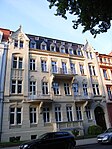
|
|
| Residential building | Görlitz, Carl-von-Ossietzky-Straße 9 | 1896 |

|
|
| Residential building | Görlitz, Carl-von-Ossietzky-Strasse 41 | 1910 | Facade change |

|
| Villa Sydow | Görlitz, Carl-von-Ossietzky-Straße 42 | 1906/1907 |
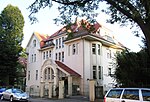
|
|
| Grain monument | Görlitz, Fahrstrasse | 1895 |
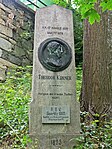
|
|
| Main building of Rothenburger Versicherung | Görlitz, Furtstrasse 1 | 1905-1907 |

|
|
| villa | Görlitz, Goethestrasse 1 | 1893 |
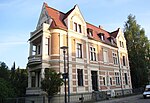
|
|
| villa | Görlitz, Goethestrasse 2 | 1893 |
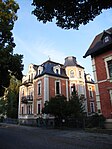
|
|
| villa | Görlitz, Goethestrasse 4 | 1900 |
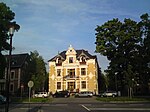
|
|
| Hagspihl Villa | Görlitz, Goethestrasse 5 | 1896/1897 |
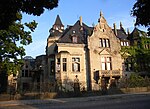
|
|
| Residential building | Görlitz, Goethestrasse 55 | 1893 |

|
|
| Residential building | Goerlitz, Langenstrasse 37 | 1926/1927 |

|
|
| Chamber of Commerce | Görlitz, Mühlweg 18 | 1895 |
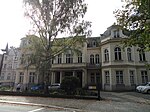
|
|
| Imperial Pavilion | Goerlitz, Obermarkt | 1893 | only for visiting Kaiser Wilhelm II. |
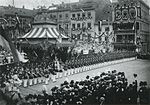
|
| Strasbourg Passage | Görlitz, Strasbourg Passage | 1908 | Portals at Berliner Strasse and Jakobstrasse |

|
literature
- Andreas Bednarek: Friedrich Paul Gerhard Röhr. An architect from Görlitz. In: Görlitzer Magazin , 7th year 1993.
- Peter Mitsching: Friedrich Paul Gerhard Röhr. Architect of Görlitz . Ed .: City Administration Görlitz, Lower Monument Protection Authority. Görlitz 2011, ISBN 978-3-00-035627-8 . ( Mitsching 2011 for short in the individual records )
Individual evidence
- ↑ Mitsching 2011 , pp. 20f.
- ↑ Mitsching 2011 , pp. 20f., P. 24, p. 28
- ↑ Mitsching 2011 , p. 24, p. 28
- ↑ Mitsching 2011 , p. 28f., P. 31, p. 35
- ↑ Mitsching 2011 , p. 63
- ↑ Mitsching 2011 , p. 116, p. 125, p. 207ff.
- ↑ Mitsching 2011 , p. 134ff., P. 145
- ↑ Mitsching 2011 , p. 223f.
- ↑ loge49.de: Ancestors "To the crowned snake" . Retrieved August 28, 2012 .
| personal data | |
|---|---|
| SURNAME | Röhr, Gerhard |
| ALTERNATIVE NAMES | Röhr, Friedrich Paul Gerhard (full name) |
| BRIEF DESCRIPTION | German architect |
| DATE OF BIRTH | July 18, 1859 |
| PLACE OF BIRTH | Goerlitz |
| DATE OF DEATH | December 30, 1930 |
| Place of death | Goerlitz |